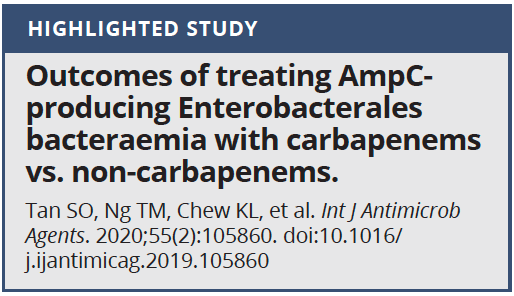Finding the Sweet Spot for Treating AmpC Beta-Lactamase-Producing Organisms: Noncarbapenem Beta-Lactams
In an era of increasing antimicrobial resis­tance, clinicians are hard-pressed to use narrow-spectrum agents to preserve antibi­otic activity.

In an era of increasing antimicrobial resis­tance, clinicians are hard-pressed to use narrow-spectrum agents to preserve antibi­otic activity. Mortality rates for patients with bacteremia secondary to AmpC β-lactamase— producing organisms have been reported to be between 10.9% and 25.6%.1,2 Clinicians commonly employ carbapenem antibiotics to treat AmpC-producing organ­isms, but because of increasing gram-negative resistance, alter­native strategies are needed.3 Although the general consensus avoids third-generation ceph­alosporins such as ceftriaxone because of the potential for emer­gence of resistance, the data supporting use of cefepime or piperacillin-tazobactam are less clear.3
Tan and colleagues explored the poten­tial for noncarbapenem β-lactam treatment of AmpC harboring gram-negative bacteria such as Enterobacter, Serratia, and Providencia spp as well as Citrobacter freundii and Morganella morganii. Of particular interest were cefepime, a poor inducer of chromosomal AmpC that also evades enzyme inactivation, and piperacillin-tazobactam, a weak inducer of AmpC.3 Because clinicians frequently use these agents empirically to treat gram-negative infections, both empiric and definitive treat­ment could be assessed.
This retrospective cohort study was conducted at 2 academic hospitals in Singapore and included patients with bacte­remia secondary to the aforementioned organ­isms. Genetic detection of AmpC was not performed but presumed based on organism. Investigators classified patients into 2 cohorts: carbapenem treatment and noncarbapenem β-lactam treatment with a primary outcome of 30-day mortality. Investigators performed a multivariate logistic regression model to identify risk factors associated with the primary outcome.
Overall, 241 patients were included. The most common sources of infection were urinary (22.8%), vascular line (22.0%), unknown (14.5%), respiratory (12.5%), and hepatobi­liary (11.6%), and most patients achieved source control (81.3%). Fifty-two patients were treated in an intensive care unit at the time of bacteremia, and the median Pitt bacteremia score was 1 (interquartile range [IQR], 0-2). Enterobacter spp comprised 58.1% of isolates, followed by Serratia spp (22.4%), M morganii (16.6%), C freundii (2.1%), and Providencia spp (0.8%). The primary outcome of 30-day mortality was met in 12.9% of patients.
Investigators did not conduct an analysis for empiric cefepime compared with carbapenems because only 2 patients received cefepime empirically. More than half of the patients were empirically treated with piperacillin-tazobactam or carbapenems (69 patients each), with a median empiric duration of 3 (IQR, 2-3) days in each group. The primary outcome was met in 11.6% of patients treated with piperacillin-tazobactam and 23.2% treated with carbapenem (P = .07). Empiric use of piperacillin-tazobactam did not influ­ence 30-day mortality in multivariate analysis (adjusted odds ratio [aOR], 0.29; 95% CI, 0.07- 1.27). Propensity score—adjusted independent risk factors for mortality were male sex (aOR, 0.29; 95%, CI 0.10-0.79), age (aOR, 1.04; 95%, CI 1.01-1.08), and Pitt bacteremia score (aOR, 1.21; 95% CI, 1.01-1.45).
Piperacillin-tazobactam was infrequently selected as definitive therapy (5.4%); there­fore, investigators compared only definitive cefepime therapy with carbapenems. More than twice as many patients were treated with definitive carbapenems (n = 132) as those with cefepime (n = 57). The median definitive duration was 7 (IQR, 4-12) days for carbapenems and 7 (IQR, 4-11) days for cefepime. The primary outcome was met in 5.3% of patients treated with cefepime and 18.9% treated with carbapenem (P = .02). Use of cefepime for definitive therapy did not influence 30-day mortality on multivariate analysis (aOR, 0.65; 95% CI, 0.12-3.55). The only independent risk factor for mortality was Pitt bacteremia score (aOR, 1.33; 95% CI, 1.06-1.69). Using carbapenems for the dura­tion of treatment (empiric and definitive) did not influence the risk of mortality (aOR, 2.25; 95% CI, 0.86-5.91).
Although a higher Pitt bacteremia score was associated with mortality, the median scores were relatively low, which may explain the lower overall mortality rate compared with previous studies.2 Additionally, the definitive cefepime cohort included a higher incidence of infections in which cefepime would achieve higher concen­trations or would be less susceptible to inoc­ulum effect (eg, urinary tract or vascular access devices). On the contrary, more patients in the cefepime cohort did not achieve source control.
Of note, although interpretation of susceptibility results was available at both institutions, minimum inhibitory concentration (MIC) data were available for isolates at only 1 hospital (n = 132). This hospital uses European Committee on Antimicrobial Susceptibility Testing (EUCAST) break­points, whereas the other uses Clinical & Laboratory Standards Institute (CLSI) break­points. The EUCAST susceptibility breakpoints for cefepime and piperacillin-tazobactam are lower than those implemented by CLSI (1 mg/L and 8/2 mg/L vs 8 mg/L and 16/4 mg/L, respectively); therefore, concordance would be expected when evaluating this hospital’s MIC data using either society’s breakpoints. However, the MIC distribution is unknown for the remaining 109 isolates interpreted according to CLSI criteria. This is noteworthy because treatment with cefepime for Enterobacter bacteremia when MICs were 4 or 8 mg/L was associated with mortality in a previous study.4 Such an elevation in cefepime MICs can be indicative of coproduc­tion of extended-spectrum β-lactamases in the absence of genotypic testing.5
Overall, this study supports empiric use of piperacillin-tazobactam for bacteremia secondary to presumed AmpC-harboring organisms and definitive therapy with cefepime, especially in infections for which lower inoculums or higher drug concentra­tions are expected. Definitive treatment with piperacillin-tazobactam cannot be established based on this study. The results are consis­tent with those of previous studies that have evaluated these noncarbapenem β-lactams for treatment of AmpC-producing organ­isms.6,7 The ongoing prospective, randomized, controlled MERINO II trial (NCT02437045) seeks to establish the utility of piperacillin-tazobactam compared with meropenem in low-risk patients with bacteremia caused by AmpC-producing organisms.8
Terico is an infectious diseases clinical pharmacy specialist at Jefferson Northeast in Philadelphia, Philadelphia, where she has been practicing since 2014. She completed a PGY1 in pharmacotherapy and a PGY2 in infectious diseases pharmacotherapy at Temple University Hospital, also in Philadelphia. *She is an active member of the Society for Infectious Diseases Pharmacists.
References:
- Kim BN, Lee SO, Choi SH, et al. Outcome of antibiotic therapy for third-generation cephalosporin-resistant gram-negative bacteraemia: an analysis of 249 cases caused by Citrobacter, Enterobacter and Serratia species. Int J Antimicrob Agents. 2003;22(2):106-111. doi:10.1016/s0924-8579(03)00094-3
- Kang CI, Kim SH, Park WB, et al. Bloodstream infections caused by Enterobacter species: predictors of 30-day mortality rate and impact of broad-spectrum cephalosporin resistance on outcome. Clin Infect Dis. 2004;39(6):812-818. doi:10.1086/423382
- Jacoby GA. AmpC beta-lactamases. Clin Microbiol Rev. 2009;22(1):161-82. doi:10.1128/CMR.00036-08
- Lee NY, Lee CC, Li CW, et al. Cefepime therapy for monomicrobial Enterobacter cloacae bacteremia: unfavorable outcomes in patients infected by cefepime-susceptible dose-dependent isolates. Antimicrob Agents Chemother. 2015;59(12):7558-7563. doi:10.1128/AAC.01477-15
- Tamma PD, Doi Y, Bonomo RA, et al. A primer on AmpC β-lactamases: necessary knowledge for an increasingly multidrug-resistant world. Clin Infect Dis. 2019;69(8):1446-1455. doi:10.1093/cid/ciz173
- Tamma PD, Girdwood SCT, Gopaul R, et al. The use of cefepime for treating AmpC β-lactamase-producing Enterobacteriaceae. Clin Infect Dis. 2013;57(6):781-788. doi:10.1093/cid/cit395
- Siedner MJ, Galar A, Guzmán-Suarez BB, et al. Cefepime vs other antibacterial agents for the treatment of Enterobacter species bacteremia. Clin Infect Dis. 2014;58(11):1554-1563. doi:10.1093/cid/ciu182
- Trial of meropenem versus piperacillin-tazobactam on mortality and clinical response (MERINO II). ClinicalTrials.gov. Updated May 2, 2018. Accessed March 22, 2020. https://clinicaltrials.gov/ct2/show/NCT02437045

